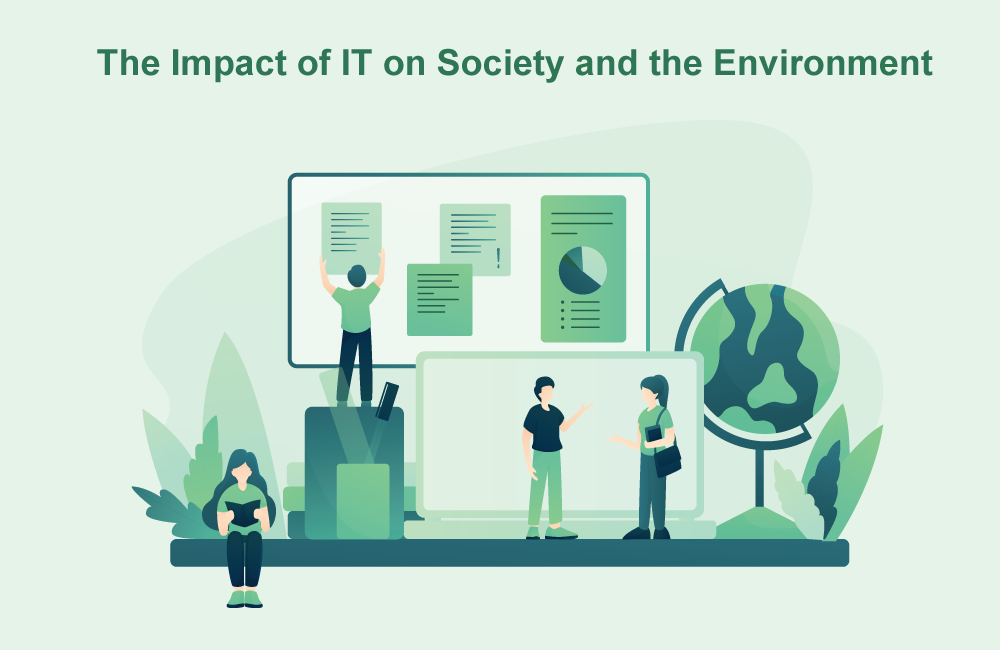The Impact of IT on Society and the Environment
Growing quickly during the last few decades is technology. The use of technology is also growing significantly. It influences people’s lives and modifies their modes of expression, education, and thought. It significantly affects civilization, and it is difficult to imagine modern life without it. Society and technology are intertwined, dependent on, and influenced by one another. Society is impacted by technology, which can advance or revert in both favorable and harmful ways. Both positive and bad effects of technology can be seen in our culture. Human civilizations and technology have been closely intertwined since the invention of technical devices like cell phones and computers. Humans produce TV and other media, which reflect the fundamental needs and way of life of a society. Although technology enhances the human lifestyle, it also poses a serious threat to the next generations. These days, people use technology excessively, which results in less physical exercise and directly affects their health. A rise in cybercrimes, in which a victim’s identity or personal information—such as a Unique ID number, PAN number, debit card, etc.—is stolen and used without our knowledge to conduct a crime or commit fraud, has also been attributed to an overreliance on technology.

Its Positive Impacts on Society
Enhancing Communication and Connectivity
Communication and interpersonal connections have undergone a striking metamorphosis as a result of IT’s rapid growth. From the before days of telephony to the trendy era of social media and instant messaging services, it has recreated a crucial role in clearing barriers to communication and fostering connections on a worldwide scale.
Contact and details are now extensively disseminated by practically everyone on the ground thanks to the evolution of the internet. The way people interact with close buddies and family, however of where they live geographically, was revolutionized via networking platforms like Twitter, Instagram, and Facebook, to name a periodic. Thanks to these mediums, it is now feasible to interact with treasured ones in their current form anywhere in the world.
Additionally, it has affected the evolution of video conferencing devices like Zoom, Microsoft Teams, and Skype, which are now necessary for practical and efficient conspiracy. These tools make it possible to have face-to-face conversations with individuals or groups that are separated over long distances. This has become more crucial in recent years since companies are now able to operate effectively even when they are physically separated thanks to remote work and virtual meetings.
Revolutionizing the Healthcare Industry
The innovation and revolution that information technology (IT) has brought to the healthcare industry has greatly increased patient care, medical research, and healthcare management. From telemedicine to electronic health records, it has fundamentally altered how healthcare is provided and shared.
One of IT’s greatest assistance to the healthcare sector is the digitization of medical records. Because electronic fitness documents (EHRs) have replaced conventional paper-based records, healthcare providers can now fast and securely access forbearing information. Offering a thorough and centralized library of medical history, prescriptions, test findings, and treatment plans, has expedited patient care. Improvements in patient outcomes can be achieved by doctors’ better decision-making, decreased medical errors, and smoother collaboration with other healthcare professionals.
Another extraordinary development made possible by IT, telemedicine, has completely changed how healthcare services are obtained and provided. Patients can consult with doctors remotely through video chats or online platforms thanks to telemedicine, which has grown in popularity in recent years. People who might not have simple access to healthcare facilities or who are unable to travel can now receive medical care. Not only has telemedicine increased access to healthcare, but technology has also proved crucial in managing public health emergencies by enabling remote monitoring and virtual consultations.
Enabling Remote Work and Education
A new era of adaptability and accessibility in both the workplace and the classroom has arrived because of the widespread deployment of information technology (IT). The way people work and learn has been revolutionized by the convergence of digital technologies, communication platforms, and online resources, making remote employment and education more viable and significant than ever.
The conventional boundaries of the workplace have been significantly weakened thanks in large part to information technology. Individuals can now work from the convenience of their homes or any location with internet access thanks to the development of IT tools and connectivity. This transformation has provided organizations with the option to access a global talent pool without being restricted by geographical constraints, in addition to improving work-life balance for employees. A few examples of virtual collaboration solutions that have made it possible for remote teams to collaborate effectively include project management software, cloud-based document sharing, and video conferencing. Businesses are now able to sustain productivity and encourage teamwork despite geographically separated team members.
Environmental Considerations in IT
Energy Consumption and E-Waste
Numerous advantages have resulted from the expansion of information technology (IT), but it has also led to serious worries about energy consumption and electronic trash, or “e-waste.” As the demand for IT goods and services increases, addressing these environmental challenges is crucial for creating a sustainable hereafter.
The rapid development of IT infrastructure, including databases, cloud computing, and web connectivity, has resulted in a huge rise in power consumption. The computers and cooling techniques in data camps, which home a lot of digital data and sustain a lot of internet assistance, require a lot of energy to run and maintain. This has put significant stress on energy resources and a footprint on the environment.
This problem is being worked on by creating more energy-efficient hardware, data center layouts, and cooling technologies. For instance, virtualization enables the operation of several virtual servers on a single physical server, optimizing resource usage and lowering energy requirements. Additionally, the use of sources for data centers, such solar and wind power, is assisting in reducing the negative environmental effects of the energy consumption associated with IT.
Effects of Technology on Society
Technology, in its most straightforward form, is a tool developed via the application of scientific details to aid in the presentation of goods and usefulness as well as the explanation of human issues. Models of technology include the Internet, phones, autos, airplanes, youngsters’ toys, and other instruments. Society has been significantly impacted by these technological advancements. The flow of individuals and something has rushed and become more specific. Internet and transferable technology have completed it easier for people to link and share ideas. Triumph in the current world is unthinkable without technology. The use of technology is ubiquitous today. This workshop will go in-depth on the implications of technology on society and the environment.
How Has Technology Impacted Society
Technology has had a profound impact on and revolutionized society. Before the development of current technology, most rural inhabitants were hunters and gatherers who lived in devised homes in rural locations. There stood much economic movement going on at the moment. Some of the most important improvements came from agribusiness technology. This is when people first discovered how to cultivate and get their fields ready to grow food. More people began to move from their rural homes to cities and enterprises that produced things in big quantities as a result of the increased availability of food.
The manufacture of tastier and more nourishing food has considerably benefited from technology, ensuring better health for people. People now consume less expensive, healthier food that is also simple to grow. Some people no longer order their favorite delicacies from hotels because they can do so over the phone or online. Food is delivered to their homes or workplaces once they place an order. Examples of items that are manufactured in vast quantities and at various rates and are accessible to everyone include clothing, footwear, and bedding.
Positive Impacts of technology on society:
Technology has more positive effects on people and society than negative ones. It rewards us by granting us access to tools or resources that significantly simplify our lives while also making our lives easier. A few benefits of technology for us are as follows:
Improved Communication: Contact is the most important part of civilization since it is the means through which we create or transmit our views to one another. In the past, people employed pigeons or additional birds to deliver notes to their loved ones. After that, as technology advanced progressively, cell phones, email, etc. superseded other contact methods as the main way to share knowledge. In the modern era, we contact buddies and home via social media or email. The fastest, numerous powerful, and numerous effective tool is the media. Individuals can easily transmit with them or share knowledge with them, even though they are isolated from their loved ones by a great length.
Improvement of the educational and learning processes thanks to technology. Nowadays, people may swiftly expand their knowledge via the internet. You can access the vast majority of the material on the internet for free and from any location at any time.
Agriculture mechanized: New technologies change how farmers do their business. Society The adoption of numerous technologies and technological tools in the agricultural industry has simplified, automated, and improved farming to some extent.
Information is readily available to us at all times and places thanks to the Internet. You may use the majority of the free information on the internet to advance your knowledge, abilities, etc.
Negative Impacts of technology on society
Everything on this earth, as we live all aware, has both benefits and weaknesses. The same is true with technology; it also has harmful effects on society, including the pursuit:
Increase in unemployment: Because machinery and technical equipment are so affordable and effective today, both large and small businesses use them, which contributes to the steadily rising jobless rate.
Increased pollution: Technology has an impact on our environment in addition to people. The rate of pollution is continuously rising as a result of machinery and automobiles, which donates to global warming and different issues.
Growing health and mental issues: In the current world, technology has an impact on people’s material and mental well-being. Individuals become emotionally brittle, lagging, have problem dozing, engage in less biological exercise, and spend less while with buddies and family.
Increase in cybercrimes: The prevalence of cybercrimes has increased as a result of overuse of the internet. Some people (attackers) hurt children or innocent people (victims) for gain or amusement.
What is Environmental Technology?
Novel concepts developed to manage, track, or relieve the adverse impacts that technology has on the tumultuous earth and its utilization of help are guided to as atmosphere products, Society also known as good or technology. Atmosphere technologies include always had negative effects, but the recent worldwide increase in situations with temperature adaptability has flashed a boom in ecologically sociable technology. These technologies will enable individuals to address some of the most influential environmental issues and move to effortless, low-carbon economics.
The Paris Agreement, which was signed in 2016, comments that nearly all countries must accept major action to combat climate differences to support the rise in global temperature to beneath 2°C.
Environmental Technology Development – Examples of Environmental Technology
The favorable effects of the product of environmental technology, such as renewable energy, “intelligent technology,” electric vehicles, and carbon dioxide deduction, will be highlighted in this section.
Renewable energy
The term “clean energy” or “renewable power” refers to the management made by renewable, replenishable help such as daylight, precipitation, current, tides, swells, and geothermal fuel. The extremely beneficial environmental effects that technology has been demonstrated by the fact that humans can now harness this innate power and transform it into electrical energy or usable heat. These include but aren’t limited to, solar energy systems, wind turbines, and water turbines.
Smart residences use devices like connected sensors along with additional IoT-connected items that can be remotely watched and managed to make them as energy-effective as is practical and to respond to user needs.
A network of web-connected objects having embedded technology for sensors that may gather and share data is referred to as the Internet of Things (IoT).
Smart Technology
Smart homes use instruments like connecting detectors and other IoT-connected tools that can be remotely monitored and directed to be as energy-efficient as probable and to acclimate to user requirements.
A network of web-connected objects with entrenched detector technologies that can order business data is understood as the Internet of Things (IoT). Networked devices can “make decisions” based on this information and behave independently. For instance, intelligent thermostats keep homes at specific temperatures at specific times of the day, reducing waste, and clever lighting systems only illuminate areas that need them.
Conclusion
It has a significant and complicated impact on society and the environment. It has altered how we interact with one another, study, and conduct business while also creating environmental problems that call for creative answers. To establish a future in which the advantages of IT may be reaped without jeopardizing the welfare of our planet and its inhabitants, it is imperative to strike a healthy balance between technical development and ecological preservation. Responsible and sustainable practices must direct our progress as we navigate this digital era.


